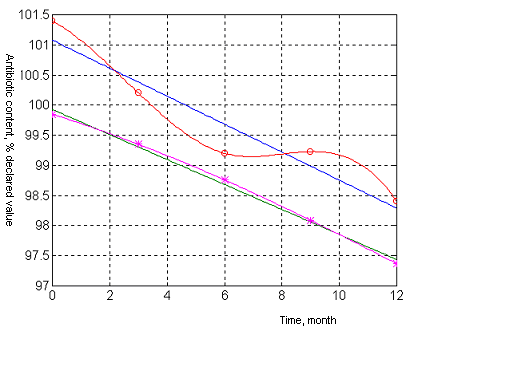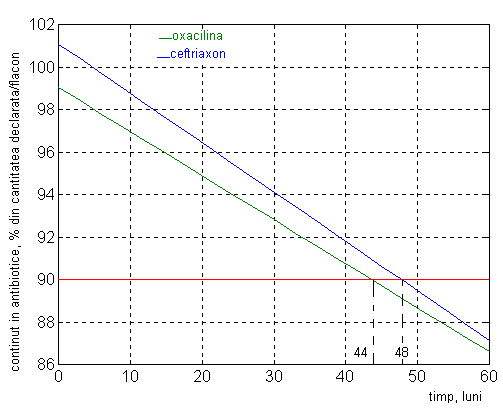STUDIES REGARDING THE STABILITY OF PHARMACEUTICAL FORMULATIONS REALIZED THROUGH
7TH GRADE SOCIAL STUDIES MEXICO & US HISTORYCENTER FOR STUDIES IN DEMOGRAPHY AND
THE GEOLOGICAL SOCIETY OF LONDON – TECTONIC STUDIES
VAAL UNIVERSITY OF TECHNOLOGY POLICY CONTINUATION OF STUDIES
(PUBLISHED IN JOURNAL OF CONSCIOUSNESS STUDIES VOL 18 NO
+ THE CENTER FOR BASQUE STUDIES EL ORIGEN DEL
Studii privind stabilitatea unor forme farmaceutice realizate prin asocierea de antibiotice beta-lactamice
Studies regarding the stability of pharmaceutical formulations realized through association of beta-lactamic antibiotics
Stability of an parenteral powder containing oxacillin and ceftriaxone

Studies regarding the stability of pharmaceutical formulations realized through association of beta-lactamic antibiotics
Stability of an parenteral powder containing oxacillin and ceftriaxone
Received for publication, May 20, 2006
Accepted, July 15, 2006
Dan Diaconu*, Corneliu Oniscu**, Cristina Vlase*, Eugen Diaconu*
* Antibiotice S.A., No 1 Valea Lupului Street, Romania
** Faculty of Industrial Chemistry, Techical University “Gh. Asachi” Iasi, Romania
E-mail: [email protected]
Abstract
Isoxazolyl penicillins (Cloxacillin, dicloxacillin, flucloxacillin and oxacillin) are very effective antibiotics in treatment of infections caused by Staphylococcus spp. Cloxacillin, dicloxacillin and oxacillin have nearly identical spectrums of activity and can be considered therapeutically equivalent when comparing in vitro activity. These penicillinase-resistant penicillins have a narrower spectrum of activity than natural penicillin. Their antimicrobial efficacy is aimed directly against penicillinase-producing strains of gram positive cocci, particularly staphylococcal species.
On the other hand, third generation cephalosporins are very effective against a large number of gram negative bacteria (including beta-lactamase - producing strains) and have poor activity against Staphylococcal species.
Ceftriaxone Sodium is a semisynthetic broad spectrum third generation cephalosporin antibiotic for intravenous and intramuscular administration.
Mixing in one pharmaceutical form oxacilline sodium and Ceftriaxone Sodium (or other third generation cephalosporin) we have obtained a new antibiotic which had a very good antibacterial activity.
In this paper we performed stability studies of a new parenteral antibiotic: an association of an third generation cephalosporin (ceftriaxone) with one isoxazolyl penicillin (oxacillin).
Keywords: ceftriaxone, oxacillin, antibiotic, beta-lactams, stability, powder for injection, association, synergism.
Introduction
Oxacillin and ceftriaxone are beta-lactam antibiotics widely used in therapy. These drugs are available on the market as powders for injection. The usual doses are: ceftriaxone 250 mg, 500 mg and 1g vial formulation, and for oxacillin 500 mg, 1g and 2g vial formulation.
Previous studies reveal that association of oxacillin with ceftriaxone yielded a new antibiotic with a wide spectrum of activity against gram positive and gram negative bacteria. (table 1.) [1]. We prepared mixture of oxacillin and ceftriaxone as follows: 500 mg oxacillin + 250 mg ceftriaxone and 1000 mg oxacillin + 500 mg ceftriaxone. In this paper are presented our research regarding stability studies of the new products.
Table 1.
|
|
|
|
C.M.I., |
g/ml |
|
|
No |
Microorganism |
oxacillin Na |
Ceftriaxone Na
|
oxacillin Na: ceftriaxone Na = 2:1 |
|
|
1. |
Streptococcus pneumoniae |
0,05 |
0,03 |
0,02 |
|
|
2. |
Staphylococcus aureus (12) |
0,25 |
1,0 |
0,2 |
|
|
3. |
Staphylococcus aureus (2)R |
0,5 |
1,0 |
0,1 |
|
|
4. |
Haemophylus influenzae |
>64 |
0,06 |
0,02 |
|
|
5. |
Escherichia coli |
>64 |
0,12 |
0,4 |
|
|
6. |
Proteus sp. |
>64 |
0,04 |
0,02 |
|
Materials and methods
Oxacillin sodium is made by Aurobindo, India and has the following parameters:
Assay 100.9%
Impurity (A,B, C, D, E) <0.1%; sum=0.1%
Water: 9.6%
White crystalline powder
pH 7.1
ceftriaxone is supplied by High Tech, Korea an has the following parameters:
assay: 860.11 µg/mg
water content: 4.56%
White crystalline powder
pH 6.17
The powder mixture was dosed in 20 ml amber vials closed tight with rubber stopper and Al cap. The powder was analyzed for performing the stability studies in dry form. After that we perform stability studies of antibiotic in solution as well using suitable solvents (so called “in use” stability testing). For this purpose the vials were kept 12 months at room temperature (25 ± 2ºC) and 6 month at 40ºC (accelerated stability studies). The solutions in suitable solvents were kept for few days at room temperature and in the refrigerator (2-5ºC)[6, 7].
For determination of the stability period of the powder in dry state we used the isotherm procedure on long term, based mainly on degradation rate of active substances. In this purpose we have determined the active substances content and related substances at three month intervals. Tests were performed using 5 vials for one analyze and considering the mean values. Interpolating the experimental values yield the mathematical model of the two antibiotics degradation in dry state. The adequacy of mathematical model was assessed using Fischer test for a confidence interval of 95%.
Based on mathematical model we assessed the stability period using a graphic method [2], intersecting the curves described by degradation equations of active substances, (respective the increase in degradation products content) with the limits described by pharmacopoeia.
The admissibility conditions were established in accordance with main international pharmacopoeias. [3,5]
Determinations of the active substances were performed using a HPLC system Agilent, model 1100. The analytical methods we used were in accordance with USP 26. [3, 4]
Admissibility conditions for powders:
ceftriaxone: 90-115%
oxacillin: 90-115%
related substances: max 1% each, sum < 5%
pH=6 – 8.5
appearance: white or almost white crystalline powder
Results and discussions
Stability studies
Long-term stability studies
Results were presented in table 2
Table 2. Stability studies on a mixture 500 mg oxacillin+250 mg ceftriaxone (as sodium salts)
|
Parameter |
Time, months |
||||
|
initial |
3 |
6 |
9 |
12 |
|
|
Ceftriaxone content, mg/vial. |
253,5 |
250,5 |
248,0 |
248,07 |
246,1 |
|
Oxacillin content mg/vial. |
499,25 |
496,65 |
493,8 |
490,45 |
486,85 |
|
Related substances: individual sum |
max.0,45% 1,45
|
max.0,47% 1,66 |
max.0,49% 2,36
|
max.0,55% 2,68
|
max.0,55% 3,05
|
|
pH |
6,88 |
6,89 |
6,76 |
6,70 |
6,71 |
|
Appearance |
Light yellow |
Light yellow |
Light yellow |
Light yellow |
Light yellow |
After 12 month at room temperature, ceftriaxone content had a 3% drop, and oxacillin content drop almost 2.5%. pH has been stable, and the color of the mixture remain the same.
As it was already mentioned, modeling the degradation process was made considering the variation in active substances content, related substances content in time (table 3.)
Table 3. Variation in Ceftriaxone and oxacillin content in time
|
Time, month |
0 |
3 |
6 |
9 |
12 |
|
Content in ceftriaxone, (% from declared content) |
101,4 |
100,2 |
99,2 |
99,23 |
98,43 |
|
Content in oxacillin (% from declared content) |
99,85 |
99,33 |
98,76 |
98,09 |
97,37 |
|
Content in related substances, % (as sum) |
1,45 |
1,66 |
2,36 |
2,68 |
3,05 |
Data obtained experimentally were used for the evaluation of the order of reaction of degradation of the two antibiotics in isotherm conditions and for the estimation of the preservation of powder at 25ºC. The degradation graphics in picture 1 were obtained in a graphic representation of the variations in time for the antibiotic concentration (as percent from the quantity declared on the vial). Figure 1.

Figure 1. The degradation of active substances from powder under preservations conditions at 25ºC for 12 months and the representation of regression equations.
As a result of interpolating the data obtained experimentally, the following regression equations were obtained:
Degradation equation in time for ceftriaxone
C1= 0,2323 t+102,08; corelation coefficient =0,9574)
Degradation equation in time for oxacilline
C2= 0,2073 t+99,928; (corelation coefficient =0,9975)
Equation describing the growth of related substances content.
C3= 0,1407 t + 1,396; (correlation coefficient =0,9879)
Where C1= ceftriaxone content /vial (as % from the declared quantity per vial)
C2 = oxacillin content /vial (as % from the declared quantity per vial)
C3 = related substances content, % (as sum)
T = time in months.
The above equations define a line, which shows that antibiotic degradation appears after an order 0 kinetic.
The graphic evaluation of stability period of the powder was achieved considering the minimum value of time (in months) that satisfies all conditions:
Time where both antibiotics have a minimum 90% from the declared content / vial
(obtained by intersecting the lines described by the regression equations with the line corresponding to the minimum admitted content /vial (picture 2a)
Time where the level of related substances is under the 5% limit ( obtained by intersecting the line described by the equation giving the growth of related substances content with the line indicating the maximum admitted content of 5%. (picture 2b).


Figure 2. The graphic evaluation of stability period for the powder mixture.
As shown in picture 2, the content of active substances remains within limits foe about 4 years, but the content of related substances overcomes the 5% limit after 26 months. Consequently, we can evaluate the powder’s stability period to 26 months (2 years).
1.2. Accelerated stability studies of the powder in isotherm conditions
In table 4 are shown the results obtained under powder preservation conditions according to the isotherm procedure at 40ºC for a period of 6 months.
After 6 months the content of active substances is still within limits, while the level of related substances and the pH overcome it. Also we notice a strong change in the powder’s color to yellow-brown. Therefore it was proved that the product cannot be preserved at temperatures higher than 25C.
Table 4. Qualitative parameters of powder for injection at 40C (medium value per 5 vials)
|
Parameter |
Time, month |
||
|
initial |
3 months |
6 months |
|
|
Content in ceftriaxone, mg/vial % from the declared content/vial |
253,5 101,4 |
243,6 97,44 |
235,5 94,22 |
|
Content in oxacillin, mg/vial % from the declared content/vial |
499,25 99,85 |
481,9 96,38 |
472,5 94,5 |
|
Related substances: individual sum |
max.0,45% 1,45 |
max.1,47% 4,93 |
max. 3,85% 10,22 |
|
pH |
6,88 |
6,23 |
10,2 |
|
Powder aspect |
Slightly yellow |
Slightly yellow |
Yellow-brown |
2. “In use” stability studies
We performed stability “in use” studies with suitable solvents in order to establish the period of use depending on the nature of solvent and temperature where the solution is preserved. The solutions were prepared by adding 3,6ml solvent to a vial containing 250 mg ceftriaxone and 500 mg oxacillin.
For this purpose we studied the stability of solutions for 10 days in the fridge (2-8C) in the absence of light and at the room temperature (24C) and natural light.
Research aimed chemical parameters, aspect and smell.
Table 5 shows the variation in time of the solution’s quality parameters.
Table 5. The variation in time of the solution’s quality parameters containing 250 mg ceftriaxone and 500 mg oxacillin / vial.
|
Time, days |
Content of ceftriaxone, % from the declared quantity/vial |
Content of oxacillin, % from the declared quantity/vial |
Related substances content, % (as sum) |
pH
|
||||
|
4C |
24C |
4C |
24C |
4C |
24C |
4C |
24C |
|
|
Water for injections |
||||||||
|
1 |
101,4 |
101,4 |
99,85 |
99,85 |
1,45 |
1,45 |
6,88 |
6,88 |
|
2 |
99,23 |
98,9 |
99,24 |
98,8 |
2,75 |
3,87 |
6,78 |
6,72 |
|
3 |
97,87 |
94,3 |
96,33 |
95,55 |
3,21 |
4,68 |
6,73 |
6,31 |
|
4 |
95,5 |
89,77 |
93,55 |
92,44 |
4,66 |
5,52 |
6,25 |
5,89 |
|
5 |
92,44 |
- |
90,13 |
89,23 |
5,3 |
- |
6,16 |
- |
|
6 |
90,3 |
- |
87,33 |
- |
- |
- |
6,08 |
- |
|
7 |
89,82 |
- |
- |
- |
- |
- |
5,78 |
- |
|
solution 0,9% NaCl |
||||||||
|
1 |
101,4 |
101,4 |
99,85 |
99,85 |
1,45 |
1,45 |
6,88 |
6,88 |
|
2 |
99,44 |
98,77 |
99,52 |
98,76 |
2,86 |
3,56 |
6,78 |
6,49 |
|
3 |
97,67 |
94,55 |
96,35 |
95,62 |
3,51 |
4,93 |
6,73 |
6,22 |
|
4 |
95,34 |
89,87 |
93,66 |
92,66 |
4,53 |
5,82 |
6,25 |
5,67 |
|
5 |
92,56 |
- |
90,22 |
89,02 |
5,75 |
- |
6,16 |
- |
|
6 |
90,45 |
- |
88,67 |
- |
- |
- |
6,08 |
- |
|
7 |
89,70 |
- |
- |
- |
- |
- |
5,78 |
- |
|
solution 5% dextrose in water |
||||||||
|
1 |
101,4 |
101,4 |
99,85 |
99,85 |
1,45 |
1,45 |
6,88 |
6,88 |
|
2 |
97,92 |
92,45 |
96,33 |
92,4 |
2,85 |
4,22 |
6,68 |
6,45 |
|
3 |
91,75 |
88,77 |
91,34 |
86,6 |
4,76 |
5,63 |
6,55 |
6,04 |
|
4 |
89,56 |
- |
89,55 |
- |
5,12 |
- |
6,47 |
5,23 |
|
5 |
- |
- |
- |
- |
- |
- |
6,0 |
- |
|
6 |
- |
- |
- |
- |
- |
- |
5,67 |
- |
|
1% lidocaine solution |
||||||||
|
1 |
101,4 |
101,4 |
99,85 |
99,85 |
1,45 |
1,45 |
6,88 |
6,88 |
|
2 |
97,35 |
89,56 |
91,44 |
88,12 |
3,21 |
5,55 |
6,44 |
5,25 |
|
3 |
90,44 |
- |
87,65 |
- |
4,53 |
- |
5,65 |
- |
|
4 |
89,25 |
- |
- |
- |
5,87 |
- |
- |
- |
Analyzing the data from the above table we emphasize the following stability of the prepared solutions:
Table 6. “In use” solution stability
|
Nr. crt. |
Solvent |
stability, days |
|
|
4C |
24C |
||
|
1. |
Water for injections |
4 |
3 |
|
2. |
Isotonic solution NaCl |
4 |
3 |
|
3. |
5% dextrose solution |
3 |
2 |
|
4. |
1% lidocaine |
2 |
1 |
Conclusions
There was achieved an association of isoxazolyl penicillins with third generation cephalosporin (1:2 in ratio) in a unique pharmaceutical form for injection.
There was studied the stability of the mixture of oxacillin both as dry state and solution, using adequate solvents.
Research proved that the mixture of oxacillin and ceftriaxone is stable preserved at temperatures under 25C for a period of minimum 2 years.
There was established the kinetics of active substances degradation in the above mentioned preservation conditions.
The stability of the “in use” solutions is 1 to 3 days preserved at room temperature and 1 to 4 days preserved in the fridge, according the nature of the used solvent.
The mixture of antibiotics allows the treatment of a large range of bacteria infections.
References
1. Eugen Diaconu, DAN Diaconu, Vlase Cristina, Poiata Antonia, Nechifor Mihai - Antibiotic cu spectru larg de actiune, Brevet Romania No. 116457 B1 din 02.2001
2. Grecu I.,E. Curea, Stabilitatea medicamentelor, Editura Medicală, Bucureşti, 1987, 330-359.
3. United States Pharmacopeia 26, Ceftriaxone for injection, pp. 386-388 (2002)
4. United States Pharmacopeia 26, Oxacillin for injection, pp. 1355-1357 (2002)
5. European Pharmacopeia ed. A-V-a (2004)
6. EMEA, CPMP/QWP/556/96. Note for Guidance on Stability Testing of Existing Active Substances and Related Finished Products, 1998
7. Agenţia Naţională a Medicamentului, Ghid privind testarea stabilităţii substanţelor medicamentoase existente şi produselor finite care le conţin, Buletin informativ an 2, nr. 2(6), trim.II, 2000
038 LEARNING AGREEMENT FOR STUDIES LEARNING AGREEMENT FOR STUDIES
1 ABACUSA JOURNAL OF ACCOUNTING FINANCE AND BUSINESS STUDIES
1 INCLUSION OF CHILDREN POLICY CASE STUDIES MARCH 1999
Tags: formulations realized, pharmaceutical formulations, pharmaceutical, realized, formulations, stability, regarding, through, studies
- 2017 SCHREIBER HIGH SCHOOL COMMON SCHOLARSHIP APPLICATION AGATE SCHOLARSHIPBALTIMORE
- FICHA RECOGIDA DE DATOS NOMBRE DEL AMPA CIF NOMBRE
- ALLEGATO 1 PROPOSTA DI ADOZIONE LIBRI DI TESTO
- FICHA 35 MATERIA DESCRIPCIÓN PERSONAL CONCURSO PARA
- MIDDLE SCHOOL COMPULSORY ROUTINE FLOOR EXERCISE LEVEL 4
- HAZARD COMMUNICATION PROGRAM IS THERE A LIST OF
- TIÊU CHUẨN NGÀNH 14 TCN 831991 QUY TRÌNH XÁC
- DE VUYST H CLIFFORD GM NASCIMENTO MC MADELEINE MM
- FICHA AUDICIÓN NOMBRE APELLIDOS REGISTRO DE VOZ FECHA
- RESULTADOS PRELIMINARES DE LA CARACTERIZACIÓN DEL PERFIL LIPÍDICO DE
- FICHA DE CREACIÓN DE GRUPOS DE TRABAJO SEMTSI NOMBRE
- DOCUMENTO DE CONSENTIMIENTO INFORMADO PARA BLEFAROPLASTIA1 DDÑA………………………………………………………………………………DE…………AÑOS DE EDAD
- WNIOSEK NA WYDANIE WARUNKÓW TECHNICZNYCH PRZYŁĄCZENIA DO SIECI WODOCIĄGOWEJ
- JANUSZ SZYMBORSKI MA∏GORZATA LEWANDOWSKA WITOLD ZATOƑSKI NINA OGIƑSKABULIK TAMARA
- OFFICE USE APPLICATION FORM PLEASE COMPLETE THIS FORM
- NOMBRE JOSÉ LUIS CABRERA PONCE LUGAR Y FECHA DE
- ANTOLOGÍA DE ROMANCES LOS ROMANCES FRONTERIZOS Y MORISCOS NARRAN
- C MAJOR 4 CP 44610 CALACEIT (TE) TEL 978
- FICHA DE PETICION DE PARCELAS DEL REGISTRO DE FINCAS
- FICHA 02 TÍTULO MÓDULO TRABAJO FINAL DE MASTER TÍTULO
- VOLCARUNCOM UN EXEMPLE DE SORTIE AU VOLCAN HUIT ARRÊTS
- INMUNOHISTOQUÍMICA EN TUMORES DE PARTES BLANDAS JORGE GARCÍA TAMAYO
- M211MR PART I CHAPTER 3 SECTION B SECTION B
- WYKAZ SZKÓŁ I PLACÓWEK NIEPUBLICZNYCH LP NAZWA PLACÓWKI ADRES
- 20 SEPTEMBER 2016 LIST OF PUBLICATIONS (CHRONOLOGICALLY) J KATAN
- REGLEMENT DE LA GESTION DES PETITES CAISSES REGLEMENT CHAQUE
- MF’S C1 COURSE AT HTTPWWWTALKINGPEOPLENETTPRAC1 HUMAN RIGHTS DECLARATION
- AEZS0442017 ZAŁĄCZNIK NR 2 DO SIWZ FORMULARZ CENOWY LP
- BU HIBE PROGRAMI AVRUPA BIRLIĞI VE TÜRKIYE CUMHURIYETI TARAFINDAN
- ZAŁĄCZNIK NR 1 DO SIWZ – OPIS PRZEDMIOTU ZAMÓWIENIA
REPUBLIKA HRVATSKA MINISTARSTVO ZNANOSTI OBRAZOVANJA I ŠPORTA NASTAVNI PLAN
 MERHABA BU SESLI ANLATIM ILE BAYT ENTEGRE PROGRAMI IÇERISINDE
MERHABA BU SESLI ANLATIM ILE BAYT ENTEGRE PROGRAMI IÇERISINDEES POR TODO POR ELLO POR LO QUE SE
(STATYTOJO (UŽSAKOVO) FIZINIO ASMENS VARDAS PAVARDĖ GIMIMO
STELLOS STADIUM IN NASHUA NH FROM THE NORTH TAKE
 P ÁGINA PERSONAL DEL DOCENTE CESAR PICCIRILLI EMAIL CESARPICCIRILLIHOTMAILCOM
P ÁGINA PERSONAL DEL DOCENTE CESAR PICCIRILLI EMAIL CESARPICCIRILLIHOTMAILCOMNVQ STUDY SKILLS BRIDGING PROGRAMME TO HIGHER EDUCATION FURTHER
 MUĞLA BAROSU ADLİ YARDIM YÖNERGESİ MUĞLA BAROSU ADLİ YARDIM
MUĞLA BAROSU ADLİ YARDIM YÖNERGESİ MUĞLA BAROSU ADLİ YARDIM ŚLĄSKI URZĄD WOJEWÓDZKI W KATOWICACH 40032 KATOWICE UL
ŚLĄSKI URZĄD WOJEWÓDZKI W KATOWICACH 40032 KATOWICE ULTHE DUNDEE NEARLY NEW NAPPY NETWORK NEARLY NEW NAPPY
BOARDINGGROOMING RECORD OWNER’S NAME PET’S NAME BREED
SCENARIJUS DUOK MOKINIUI SPARNUS SUSIRENKA Į SCENĄ MOKINIAI TYLIAI
PRESTON SCHOOL DISTRICT REGULAR BUSINESS MEETING DISTRICT OFFICE DATE
 0 (1) MEDICINAL PRODUCT DETAILS INVENTED NAME OF MEDICINAL
0 (1) MEDICINAL PRODUCT DETAILS INVENTED NAME OF MEDICINAL E SCUELA DE ANIMACIÓN JUVENIL Y TIEMPO LIBRE “360
E SCUELA DE ANIMACIÓN JUVENIL Y TIEMPO LIBRE “360 OFFICE USE ONLY GRADUATE CURRICULUM APPROVAL FORM NEW
OFFICE USE ONLY GRADUATE CURRICULUM APPROVAL FORM NEW PREFEITURA MUNICIPAL DE CORGUINHO MEMORIAL DESCRITIVO COBERTURA DO
PREFEITURA MUNICIPAL DE CORGUINHO MEMORIAL DESCRITIVO COBERTURA DO CAJUNS CREOLES PIRATES AND PLANTERS YOUR NEW LOUISIANA ANCESTORS
CAJUNS CREOLES PIRATES AND PLANTERS YOUR NEW LOUISIANA ANCESTORS Z ESPÓŁ SZKÓŁ PONADGIMNAZJALNYCH W SOMPOLNIE UL GIMNAZJALNA 2
Z ESPÓŁ SZKÓŁ PONADGIMNAZJALNYCH W SOMPOLNIE UL GIMNAZJALNA 2 …………………………………………20 KEPADA NOMOR YTH BUPATI SUMBAWA LAMPIRAN
…………………………………………20 KEPADA NOMOR YTH BUPATI SUMBAWA LAMPIRAN